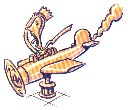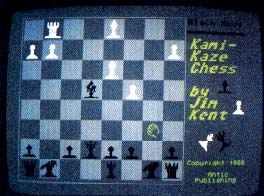

ON DISK!
KAMIKAZE CHESS
by Jim Kent and Heidi Brumbough
If you think chess is a staid old pastime, let START put some new life into the Game of Kings. Play Jim Kent's Kamikaze Chess against a friend or the computer, and see who can "win" by losing all their pieces. This game isn't as easy as it sounds and requires you to think on your feet. Runs in medium or low resolution on a color monitor.
You can win for losing--file KAMIKAZE.ARC on your START disk!
Kamikaze Chess is a mirror-image chess game. It's played like standard chess, but with one important difference: in this case, the object of the game is to force your opponent to take all your pieces. If you win, you lose-and vice versa!
Kamikaze was written in Aztec C and assembly language. To play, copy the files KAMIKAZE.ARC and ARCX.TTP onto a blank, formatted disk and un-ARC the file, following the Disk Instructions elsewhere in this issue. Double-click on KAMIKAZE.PRG. At the opening screen, select either one or two players; if you play against the computer, it will have the white pieces and move first. Press Q at any point to quit the game and return to the main menu.
You can move your pieces using either the mouse or the arrow keys. When it is the computer's turn the cursor will be a busy bee; when it's your turn it will be a hand. Move the cursor into the square of the piece you wish to move and press the left mouse button. While still holding the mouse button down, move the pointer to the piece's new position and release the button. If you prefer to use the arrow keys, press any key (except Q) to highlight the last piece you moved. Then use the arrow keys to move the highlighted square to the piece you want to move and press Return. Now use the arrows to highlight the square to move to and press Return. Whichever method you use to move the pieces, you can take back your last move by pressing the Backspace key.
All legal chess moves are allowed in Kamikaze Chess, including castling and capturing pawns en passant. Castle by moving your king two spaces in the appropriate direction. If one of your pawns reaches your opponent's home row, it will automatically become a queen. If you need to brush up on legal chess moves, there are plenty of books at your local library or bookstore to get you started.
Inside the Castle
Kamikaze Chess has very few special rules, the main one being that if you are in a position where if you can take one of your opponent's pieces, you must do so. If you are in a position to take more than one piece, you can choose which one to take--but you must take one. If you are in check, however, you must move out of check, and if you can do so by taking one of your opponent's pieces you must do that.
Like standard chess, you cannot move into check. However, this rule changes when the only piece you have left is your king. At that point your goal is to move into check to force your opponent to take your king. If this happens, you've won the game (by losing it).
The computer will check for legal moves and will also alert you to forced capture positions if you try to move a piece instead of capturing one. Also, you can't ignore a check if you have other pieces on the board. If both kings are the only two pieces on the board, make sure that you move your king into capturing range first. Then your opponent will have to take you--and lose.
 |
We consider Kamikaze Chess an experiment in artifi- cial stupidity: the computer is pro- grammed to try to win by losing all its pieces. |
Strategy
In Kamikaze Chess, the pieces that would normally be the most valuable to you can hurt you the most. For example, one rook on your seventh row can be forced to pick off most of your opponent's pawns if he or she manipulates the situation properly. Similarly, a queen on your opponent's home row may not last very long, but could be forced to take several major pieces before she gets captured.
Pawns can't do too much damage, so if you're in a position where you can take either a pawn or another piece, your best bet is generally to take the pawn and try to force the other piece into your home row. Toward the end of the game, pawns can be difficult to get rid of, so you will probably want to turn them into queens so they'll be more mobile (Hint: you can usually get rid of a queen or a rook by putting your opponent in check twice in a row.)
Ready to lose?
The computer will make a formidable enemy, so you may want to play a few games against it to get the feel of how the game works and what strategies to use. Kamikaze Chess makes a challenging diversion from most computer games. It's fun to play, requires skill and fast thinking, and best of all, unlike many computerized chess games, it actually gives you a good chance of beating the computer.
Jim Kent is the author of Cyber Paint from Antic Software and the Audio-Visual Sequencer from the November 1988 issue of START.
ILLUSTRATIONS BY ROBERT KOPECKY